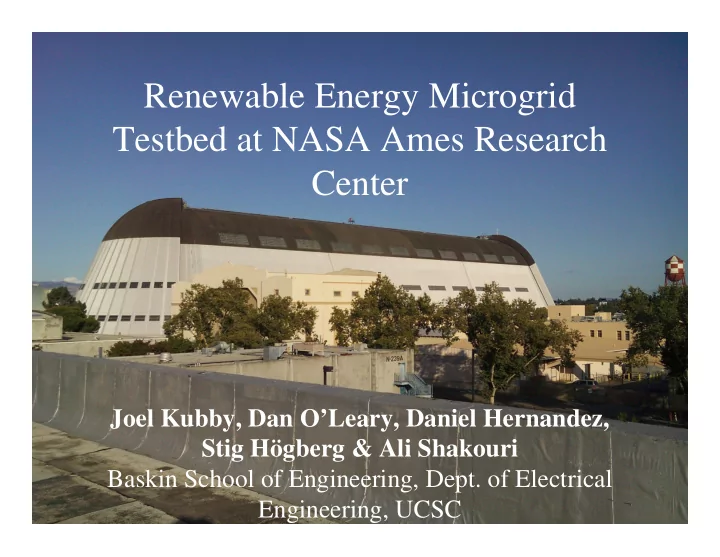

Renewable Energy Microgrid Testbed at NASA Ames Research Center Joel Kubby, Dan O’Leary, Daniel Hernandez, Stig Högberg & Ali Shakouri Baskin School of Engineering, Dept. of Electrical Engineering, UCSC
Goals • Set-up a unique microgrid test-bed for renewable energy monitoring, generation and storage • Use the facility for testing systems integration of new renewable energy components • Enable web access to the test-bed for a remote access lab in renewable energy
Microgrid Components • Energy Generation • Monitoring – Tracking photovoltaic array – IV curve tracer (Daystar (six Sharp 180W PV DS-100C) panels, Wattsun AZ 225 – Weather station (Cambell tracker) Instruments) – Wind turbine (Air X-12 – Wind anemometer 400W) – Solar radiometers • Energy Storage • Normal incidence Pyroheliometer – Batteries • Precision Spectral • 400 Ah SLA Pyranometer – Electric Vehicle – Data logger • Energy Conversion – Xantrex inverter
Background • Group project from LoCal RE 2008 Summer School on “ Electricity Grid using Localized Renewable Generation ” • Intermittent wind and solar power generation at the household scale balanced using electric vehicles
Questions • Is it possible to have a hybrid renewable energy system as a microgrid with an electric vehicle as battery storage? • Could this type of microgrid system be price-competitive with typical grid- connected systems? • How will this vary when applied to Denmark and the USA respectively?
California: Solar Resource • Highest solar radiation in the southwest (7,000 to 7,500Whr/m 2 /day, Yearly sum 2700kWh/m 2 ) • Lowest solar radiation in northwest and northeast (2,500Whr/m 2 /day) • Abundant solar resource
California: Wind Resource • Wind resource in the coastline of California • Highest wind power density of 500-800 W/m 2 and wind speed from 8.0 to 8.8 m/s. • Wind resource varies greatly with locality
Denmark: Solar Resource • Yearly sun in Jutland is between 925kWh/m 2 - 950kWh/m 2 • Lolland has the highest solar radiation with more than 1000kWh/m 2 • Less solar resource than California
Denmark: Wind Resource • Abundant wind resource in the coastline. Speed > 10m/s, density > 510W/m 2 • Wind resources vary by location, but on average are high.
Batteries
Solar Cells
System Modeling using HOMER https://analysis.nrel.gov/homer/
Selected Components • Bergey Excel-R (7.5 kW DC) • Toyota Prius with OEMTek PHEV Kit (9 kWh) • Photovoltaic (4 & 8 kW systems considered) • Outback 3.6 kW inverter (stackable)
Initial Findings • The PHEV Prius Battery is too small to balance the system. – HOMER was unable to find a system utilizing only the Prius battery. – 9 kWh of storage is not enough to balance the system in California or Denmark – ~50 kWh battery capacity is needed to run the system (Tesla EV)
Implementation of a Renewable Energy Test-bed at NASA Ames • Set up solar tracker, weather station, and complete test and measurement control room at NASA Ames • Add in wind turbine, electric vehicle energy storage and recharging station • CCLI proposal funded by NSF to put the facility on-line for a remotely accessible renewable energy laboratory • Plan to use testbed to create links with renewable energy industrial partners
Implementation of Testbed at NASA Rm 181 Ames B239N
Six Sharp 180W PV Panels Normal Precision Incidence Spectral Pyroheliometer Pyranometer (NIP) (PSP)
Precision Spectral Pyranometer (PSP)
Pyroheliometer (NIP) Normal Incidence
400Watt Air X-12 Wind Turbine
Predicted Energy Production There isn’t much wind in Mountain View! It’s so calm you could probably land a blimp!
Initial System Configuration Solar panels Wind turbine and charge controller Future grid-tie option AC distribution panel DC disconnects DC In AC In DC In Initial energy storage in batteries
Vehicle to Grid
Vehicle to Grid • Average US car: Driven 1 hour/day (2001) • Serve as: – Regulating power (frequency) • Often automatic (governor) – Spinning reserve (outages) • Standby power plants (often running at 30-40% rated) – Back-up service (microgrid)
AC Propulsion • T-Zero – Battery management – Bi-directional flow of electricity
Variable Load for Grid Stabilization One way power flow Two way power flow
Myers Motors - NMG • 15 kWh Li-ion • 80 mph • 45 miles range • 5 h full charging • 1 person • Regenerative Braking System
Green Vehicles - Triac • 23 kWh Li-ion • 80 mph • 100 mile range • 5 h full charging • 2 persons • Freeway driving • Regenerative Braking System
Tesla Roadster • 42, 65, 85 kWh Li-ion • 125 mph • 160, 230, 300 mile range • 3.5 hours (240V, 70A) • 2 persons • 0-60 mph in 3.5 seconds
Recharge Station Photo showing Electric Car at a Recharge Station from Better Place http://www.betterplace.com/
Acknowledgements • LoCal RE 2008 study group – Electricity Grid using Localized Renewable Generation; Wind and Solar Power Balanced by Electric Vehicles • Phil Chiu (UC Davis) • Stig Hoegberg, Nan Qin and Jiang (DTU) • Jeremy Hieb (UCSC) • Rose Grymes, Wenonah Vercoutere Lisa Witt, Steve Hinge, ASL • Nima Mostafi, UC Santa Cruz • Funding – UARC Aligned Research Program – BIN-RDI
Recommend
More recommend